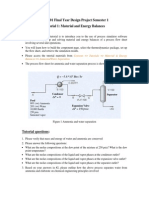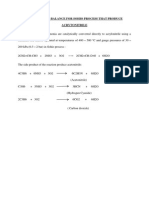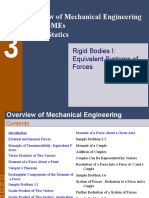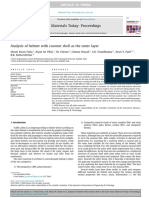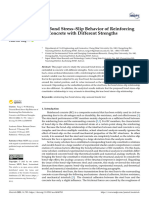SR Polar
SR Polar
Uploaded by
amritrathCopyright:
Available Formats
SR Polar
SR Polar
Uploaded by
amritrathOriginal Description:
Original Title
Copyright
Available Formats
Share this document
Did you find this document useful?
Is this content inappropriate?
Copyright:
Available Formats
SR Polar
SR Polar
Uploaded by
amritrathCopyright:
Available Formats
SR-POLAR
The SR-POLAR property method is based on an equation-of-state model by Schwarzentruber and Renon,
which is an extension of the Redlich-Kwong-Soave equation of state. You can apply the SR-POLARmethod
to both non-polar and highly polar components, and to highly nonideal mixtures. This method is
recommended for high temperature and pressure applications
SR-POLAR requires:
Polar parameters for polar components. These parameters are determined automatically using vapor
pressure data generated from the General Pure Component Liquid Vapor Pressure model.
Binary parameters to accurately represent phase equilibria. The binary parameters are temperature-
dependent.
If you do not enter binary parameters, the Aspen Physical Property System estimates them automatically
using VLE data generated from the UNIFAC group contribution method. Therefore, the SR-POLAR
property method is predictive for any interaction that UNIFAC can predict at low pressures. The accuracy of
the prediction decreases with increasing pressure. You cannot use UNIFAC to predict interactions with light
gases.
SR-POLAR is an alternative property method that you can use for nonideal systems, instead of using an
activity coefficient property method, such as WILSON.
Parameter requirements for the SR-POLAR property method are in the tables labeled Parameters Required
for the SR-POLAR Property Method (see below) and Parameters Required for Common Flexible and
Predictive Models. For details about optional parameters, and calculation of pure component and mixture
properties, see Physical Property Models.
Mixture Types
You can use the SR-POLAR property method for mixtures of non-polar and polar compounds, in
combination with light gases.
Range
You can use the SR-POLAR property method up to high temperatures and pressures. You can expect fair
predictions up to about 50 bar. You can expect reasonable results at any condition, provided UNIFAC
interaction parameters are available. But results are least accurate close to the critical point.
Parameters Required for the SR-POLAR Property Method
Thermodynamic Properties Models Parameter Requirements
Vapor and liquid mixture Schwartzentruber-Renon TC, PC, OMEGA, Optional:
Fugacity coefficient, RKUPPn, RKUCn,
Density RKUKAn, RKULAn, RKUKBn
n = 0, 1, 2
Enthalpy, General pure component ideal (CPIG or CPIGDP)
Entropy, gas heat capacity
Gibbs energy
Schwartzentruber-Renon Optional:
RKUPPn, RKUCn,
RKUKAn, RKULAn, RKUKBn
n = 0, 1, 2
You might also like
- 2 - 5 - Catalysis Catalytic ReactorsDocument34 pages2 - 5 - Catalysis Catalytic Reactorsk.shilpya30No ratings yet
- Production of N Octane From Ethylene and I ButaneDocument2 pagesProduction of N Octane From Ethylene and I ButaneRamyaNo ratings yet
- Analytical Chemistry II Classical Methods NotesDocument65 pagesAnalytical Chemistry II Classical Methods NotesOratile SehemoNo ratings yet
- Computer Applications For Chemical Engineering Practice: Exercise ProblemsDocument72 pagesComputer Applications For Chemical Engineering Practice: Exercise ProblemsChien Nguyen0% (1)
- CASE STUDY 1 - Catalytic Oxidation of SO2Document15 pagesCASE STUDY 1 - Catalytic Oxidation of SO2LuthandoNo ratings yet
- 10 Grand Canonical EnsembleDocument12 pages10 Grand Canonical EnsembleAnonymous FRKcnDx7No ratings yet
- Aspen HYSYS V10 Cumulative Patch 1 Release NotesDocument10 pagesAspen HYSYS V10 Cumulative Patch 1 Release Notespolaris44100% (1)
- Dekati DiluterDocument2 pagesDekati Diluterindra irawanNo ratings yet
- HDPE Production Via Slurry-Loop ProcessDocument1 pageHDPE Production Via Slurry-Loop ProcessBramJanssen76100% (1)
- 05 Chapter 11 (Compiled)Document106 pages05 Chapter 11 (Compiled)Haziq KhairiNo ratings yet
- Dynamic Analysis of A PFR With Aspen HYSYS V8.0: Revised: Nov 27, 2012Document6 pagesDynamic Analysis of A PFR With Aspen HYSYS V8.0: Revised: Nov 27, 2012udokasNo ratings yet
- UniSim Design Tutorials and Applications-300-446Document147 pagesUniSim Design Tutorials and Applications-300-446Fabiano Coelho de AlmeidaNo ratings yet
- HYSYS Tutorial 1 Material & Energy BalancesDocument1 pageHYSYS Tutorial 1 Material & Energy BalancesJxinLeeNo ratings yet
- Spesifikasi Ion ChromatographyDocument3 pagesSpesifikasi Ion ChromatographyYora Febri Zal PutriNo ratings yet
- Product Information Sheet: Synthite Industries Private LimitedDocument2 pagesProduct Information Sheet: Synthite Industries Private LimitedMaurice Dan GeroyNo ratings yet
- Lab # 15Document13 pagesLab # 15Kashaf TehreemNo ratings yet
- ENRTL-RK Rate Based Sulfolane-DIPA ModelDocument38 pagesENRTL-RK Rate Based Sulfolane-DIPA ModelsamandondonNo ratings yet
- Design of A Methanol-To-Olefinprocess Using Aspen Hysys: Material and Energy BalancesDocument9 pagesDesign of A Methanol-To-Olefinprocess Using Aspen Hysys: Material and Energy BalancesAbdulwahab GIWANo ratings yet
- Application of Extended HazopDocument10 pagesApplication of Extended HazopTonga ProjectNo ratings yet
- Inside-Out Algo - Boston 1974Document12 pagesInside-Out Algo - Boston 1974Jeremy HernandezNo ratings yet
- Aspen Plus Udemy - NotesDocument5 pagesAspen Plus Udemy - NotesShyamPanthavoorNo ratings yet
- Chemical Engineering Science Volume 1 Issue 4 1952 (Doi 10.1016/0009-2509 (52) 87011-3) D. Annable - Application of The Temkin Kinetic Equation To Ammonia Synthesis in Large-Scale ReactorsDocument10 pagesChemical Engineering Science Volume 1 Issue 4 1952 (Doi 10.1016/0009-2509 (52) 87011-3) D. Annable - Application of The Temkin Kinetic Equation To Ammonia Synthesis in Large-Scale Reactorsmade hNo ratings yet
- Introduction To Aspen Hysys SimulationDocument48 pagesIntroduction To Aspen Hysys Simulationpemas00001No ratings yet
- Lecture Three: Process DesignDocument57 pagesLecture Three: Process DesignAsasira IradNo ratings yet
- Styrene ProductionDocument12 pagesStyrene ProductionMoni ValinschiNo ratings yet
- Chaves 2016Document67 pagesChaves 2016Abraham GutierrezNo ratings yet
- Lecture-3, Practical, 3Document30 pagesLecture-3, Practical, 3Asasira IradNo ratings yet
- Reactor (PFR) PDFDocument10 pagesReactor (PFR) PDFHien Ngo ThiNo ratings yet
- Overall Flowsheet Simulation Benzene Cyclohexane TW6Document7 pagesOverall Flowsheet Simulation Benzene Cyclohexane TW6Mitesh ParmarNo ratings yet
- HYSYSTutorial CHEE332Document35 pagesHYSYSTutorial CHEE332Syukri ShahNo ratings yet
- Liquid-Liquid Extractions Lesson 7Document20 pagesLiquid-Liquid Extractions Lesson 7GATOMICONo ratings yet
- Computer Applications For Chemical Practice: Homework Set #1 SolutionsDocument27 pagesComputer Applications For Chemical Practice: Homework Set #1 Solutionsmadithak100% (1)
- Performance 2 (Cascade Control)Document4 pagesPerformance 2 (Cascade Control)Jorge Chávez BarbozaNo ratings yet
- Aspen HYSYS Training: Module 5: UtilitiesDocument8 pagesAspen HYSYS Training: Module 5: UtilitiestaeebNo ratings yet
- Material and Balance For Sohio Process That Produce AcrytonitrileDocument2 pagesMaterial and Balance For Sohio Process That Produce Acrytonitrileafnan_lion940% (1)
- Kinetics of Acetone Hydrogenation For Synthesis of Isopropyl Alcohol Over Cu-Al Mixed Oxide CatalystsDocument9 pagesKinetics of Acetone Hydrogenation For Synthesis of Isopropyl Alcohol Over Cu-Al Mixed Oxide Catalysts李国俊No ratings yet
- Classes Hysys 5 Reactions and ReactorsDocument7 pagesClasses Hysys 5 Reactions and ReactorsAhmed AliNo ratings yet
- Ch4-E - Fogler-4th Ed PDFDocument16 pagesCh4-E - Fogler-4th Ed PDFsandra thalia parmithaNo ratings yet
- CHM170L Exp1 Determination of Molar MassDocument5 pagesCHM170L Exp1 Determination of Molar MassKaiser SaltoNo ratings yet
- Aspen PDFDocument69 pagesAspen PDFBigNo ratings yet
- Design of A Plug Flow Reactor (PFR) : Parameters ValuesDocument10 pagesDesign of A Plug Flow Reactor (PFR) : Parameters ValuesDee RajanNo ratings yet
- Separations and Reaction Engineering Design Project Styrene ProductionDocument10 pagesSeparations and Reaction Engineering Design Project Styrene ProductionLokesh EmandiNo ratings yet
- 04 Distillation SequencingDocument36 pages04 Distillation SequencingHasnin ArifianiNo ratings yet
- Cpe 613 Project Simulation: Production of Propylene GlycolDocument11 pagesCpe 613 Project Simulation: Production of Propylene GlycolDafiMaboNo ratings yet
- Methanol SynthesisDocument21 pagesMethanol SynthesisAnonymous cenxRyKU5No ratings yet
- Benzene: Chemical Economics HandbookDocument3 pagesBenzene: Chemical Economics HandbookMaría VásquezNo ratings yet
- C4-Based Processes 8-01-11Document18 pagesC4-Based Processes 8-01-11Sistine Maquiling Cobcoban100% (1)
- 01 Hysys IntroDocument21 pages01 Hysys Introsyamsudin2006No ratings yet
- Je300655b PDFDocument60 pagesJe300655b PDF方琳 徐No ratings yet
- Stage & Continuous Gas-Liquid Separation Processes: Chapter ThreeDocument116 pagesStage & Continuous Gas-Liquid Separation Processes: Chapter ThreeDoni RopawandiNo ratings yet
- T Tai: U YstDocument7 pagesT Tai: U YstDani Romero GarzònNo ratings yet
- ASPEN PLUS (v7.3) (2011-03) - Aspen Physical Property System - Physical Property MethodsDocument245 pagesASPEN PLUS (v7.3) (2011-03) - Aspen Physical Property System - Physical Property Methodsthiarap23No ratings yet
- Matlab - Equations of StateDocument23 pagesMatlab - Equations of StateMia Beatrice Benavidez MawiliNo ratings yet
- Mea E11a B ShortDocument15 pagesMea E11a B ShortMeli GerberNo ratings yet
- CHE 4170 Design Project HYSYSDocument16 pagesCHE 4170 Design Project HYSYSPhan Nee100% (1)
- 17 Mayuresh QSAR-A NOVEL TOOL IN DRUG DESIGNDocument14 pages17 Mayuresh QSAR-A NOVEL TOOL IN DRUG DESIGNpjalat bpibNo ratings yet
- Thermodynamic Analysis of Supercritical Organic Rankine Cycle With Propane (R-290) As A Working FluidDocument16 pagesThermodynamic Analysis of Supercritical Organic Rankine Cycle With Propane (R-290) As A Working FluidHarmenNo ratings yet
- Creatine Kinase: Store at 2-8ºCDocument4 pagesCreatine Kinase: Store at 2-8ºCLaboratorios HerliNo ratings yet
- Potential Energy SurfaceDocument21 pagesPotential Energy SurfaceSIDDHARTH MARATHANo ratings yet
- Electron Paramagnetic Resonance in Modern Carbon-Based NanomaterialsFrom EverandElectron Paramagnetic Resonance in Modern Carbon-Based NanomaterialsNo ratings yet
- Agitated VesselsDocument12 pagesAgitated VesselsFren2008100% (11)
- Slope StabilityDocument4 pagesSlope StabilityKevin Jairo SantiagoNo ratings yet
- Design of RCC DrainsDocument7 pagesDesign of RCC DrainsSatyanarayana Balaraman100% (2)
- Physics Hard MCQs Topic WiseDocument38 pagesPhysics Hard MCQs Topic WiseAttique RehmanNo ratings yet
- Singularity FunctionsDocument1 pageSingularity FunctionsCharlie SiaNo ratings yet
- Chapter 13 Reveiw-Part 1Document10 pagesChapter 13 Reveiw-Part 1patNo ratings yet
- Connection Design For Column Above Beam, Based On AISC Manual & AISC 360-05Document1 pageConnection Design For Column Above Beam, Based On AISC Manual & AISC 360-05RayodcNo ratings yet
- SAFE Appendix B - Deflection CalculationsDocument9 pagesSAFE Appendix B - Deflection CalculationsMahmood MuftiNo ratings yet
- Basic Notions of Celestial MechanicsDocument36 pagesBasic Notions of Celestial MechanicsEbn MisrNo ratings yet
- Slope StabilityDocument17 pagesSlope StabilityRajesh Prasad ShuklaNo ratings yet
- USIT - Ultrasonic Imager Tool Presentation FEDocument27 pagesUSIT - Ultrasonic Imager Tool Presentation FEmortizNo ratings yet
- Design and Development of Box Shifting Mechanism Using Gearless Power Transmission SystemDocument4 pagesDesign and Development of Box Shifting Mechanism Using Gearless Power Transmission SystemInternational Journal of Innovative Science and Research TechnologyNo ratings yet
- Manthan Patel Analysis II HW #9: Example 6.1Document15 pagesManthan Patel Analysis II HW #9: Example 6.1manthan212No ratings yet
- Impulse Turbine Questions g3Document8 pagesImpulse Turbine Questions g3VipulKukkar100% (2)
- Heat and Mass TransferDocument537 pagesHeat and Mass TransferShafeequ Rahman100% (1)
- Statics of Rigid BodiesDocument34 pagesStatics of Rigid BodiespesobucksNo ratings yet
- Polygon Law of ForcesDocument1 pagePolygon Law of ForcesNitin100% (1)
- CALTRANS+Seismic+Design+Criteria V1.5 (2010.11)Document197 pagesCALTRANS+Seismic+Design+Criteria V1.5 (2010.11)Soowhan JungNo ratings yet
- Chapter 12. Heat Transfer To Fluids Without Phase ChangeDocument10 pagesChapter 12. Heat Transfer To Fluids Without Phase ChangeSwapna VadlamaniNo ratings yet
- A Simple Model To Predict The Fundamental Frequency of The Reinforced Concrete Dome Structure of A Double Shell Underground Tank PDFDocument22 pagesA Simple Model To Predict The Fundamental Frequency of The Reinforced Concrete Dome Structure of A Double Shell Underground Tank PDFmahmood hunarNo ratings yet
- Materials Today: ProceedingsDocument9 pagesMaterials Today: ProceedingsAditya RachmanNo ratings yet
- g1d - Polygonofforces 281 29Document8 pagesg1d - Polygonofforces 281 29hafizudean143No ratings yet
- EMD Micro ProjectsDocument3 pagesEMD Micro ProjectsSoham MisalNo ratings yet
- Pullout Test Monotonic LoadingDocument21 pagesPullout Test Monotonic Loading429e10d421No ratings yet
- Condenser SimulationDocument8 pagesCondenser SimulationAmir AbbaszadehNo ratings yet
- Composite Floors PDFDocument17 pagesComposite Floors PDFmuru0105No ratings yet
- dydx=tanθ dydx=ω2xg dy=ω2gx dx y=ω2x22g: Other FormulasDocument2 pagesdydx=tanθ dydx=ω2xg dy=ω2gx dx y=ω2x22g: Other Formulasangelica brongcanoNo ratings yet
- ThanosDocument62 pagesThanosKim Ryan PomarNo ratings yet
- Arche2 Module 1Document19 pagesArche2 Module 1Justine MonteroNo ratings yet
- Work Power and EnergyDocument51 pagesWork Power and EnergyJohn Carlo FranciscoNo ratings yet












